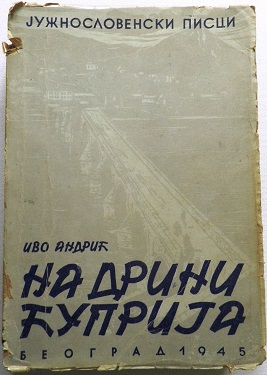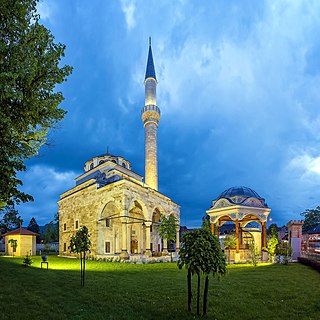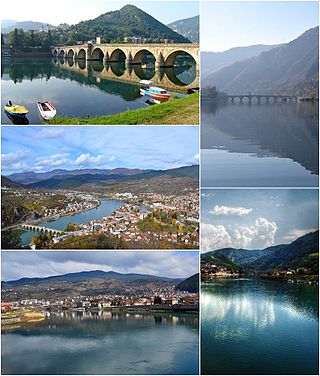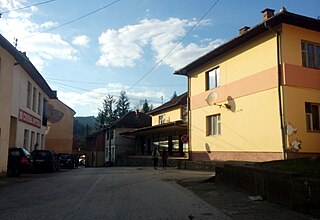
Republika Srpska is one of the two entities within Bosnia and Herzegovina, the other being the Federation of Bosnia and Herzegovina. Situated in the northern and eastern regions of the country, it recorded a population of 1,228,423 in the 2013 census. Its largest city and administrative hub is Banja Luka, located on the banks of the Vrbas River.

Sokollu Mehmed Pasha was an Ottoman statesman of Serb origin most notable for being the Grand Vizier of the Ottoman Empire. Born in Ottoman Herzegovina into an Orthodox Christian family, Mehmed was recruited as a young boy as part of so called "blood tax" to serve as a janissary to the Ottoman devşirme system of recruiting Christian boys to be raised as officers or administrators for the state. He rose through the ranks of the Ottoman imperial system, eventually holding positions as commander of the imperial guard (1543–1546), High Admiral of the Fleet (1546–1551), Governor-General of Rumelia (1551–1555), Third Vizier (1555–1561), Second Vizier (1561–1565), and as Grand Vizier under three sultans: Suleiman the Magnificent, Selim II, and Murad III. He was assassinated in 1579, ending his near 15-years of service to several Sultans, as sole legal representative in the administration of state affairs.

The Bridge on the Drina is a historical novel by the Yugoslav writer Ivo Andrić. It revolves around the Mehmed Paša Sokolović Bridge in Višegrad, which spans the Drina River and stands as a silent witness to history from its construction by the Ottomans in the mid-16th century until its partial destruction during World War I. The story spans about four centuries and covers the Ottoman and Austro-Hungarian occupations of the region, with a particular emphasis on the lives, destinies, and relations of the local inhabitants, especially Serbs and Bosnian Muslims.

Mimar Sinan also known as Koca Mi'mâr Sinân Âğâ, was the chief Ottoman architect, engineer and mathematician for sultans Suleiman the Magnificent, Selim II and Murad III. He was responsible for the construction of more than 300 major structures, including the Selimiye Mosque in Edirne, the Kanuni Sultan Suleiman Bridge in Büyükçekmece, and the Mehmed Paša Sokolović Bridge in Višegrad, as well as other more modest projects such as madrasa's, külliyes, and bridges. His apprentices would later design the Sultan Ahmed Mosque in Istanbul and the Stari Most bridge in Mostar.

Ferhat Pasha Mosque, also known as the Ferhadija Mosque, is a mosque in the city of Banja Luka and one of the greatest achievements of Bosnia and Herzegovina's 16th century Ottoman Islamic architecture. The mosque was demolished in 1993 at the order of the authorities of Republika Srpska as a part of an ethnic cleansing campaign, and was rebuilt and opened on 7 May 2016.

Stari Most, also known as Mostar Bridge, is a rebuilt 16th-century Ottoman bridge in the city of Mostar in Bosnia and Herzegovina. It crosses the river Neretva and connects the two parts of the city, which is named after the bridge keepers (mostari) who guarded the Stari Most during the Ottoman era. During the Croat–Bosniak War, the Army of the Republic of Bosnia and Herzegovina used the bridge as a military supply line, and the bridge was shelled by the Croatian Defence Council (HVO) and collapsed on 9 November 1993. Subsequently, the bridge was reconstructed, and it re-opened on 23 July 2004. In 2017, the ICTY deemed that the shelling was legal and that the bridge was a legitimate military target.

Višegrad is a town and municipality in Republika Srpska, Bosnia and Herzegovina. It rests at the confluence of the Drina and the Rzav river. As of 2013, the municipality has a population of 10,668 inhabitants, while the town of Višegrad has a population of 5,869 inhabitants.

Rudo is a town and municipality in Republika Srpska, Bosnia and Herzegovina. As of 2013, it has a population of 7,963 inhabitants, while the town of Rudo has a population of 1,949 inhabitants.

Lala Mustafa Pasha, also known by the additional epithet Kara, was an Ottoman Bosnian general and Grand Vizier from the Sanjak of Bosnia.

The Drina is a 346 km (215 mi) long river in the Balkans, which forms a large portion of the border between Bosnia and Herzegovina and Serbia. It is the longest tributary of the Sava River and the longest karst river in the Dinaric Alps which belongs to the Danube River drainage basin. Its name is derived from the Roman name of the river which in turn is derived from Greek which is derived from the native name of Illyrian origin.

Sanjak of Bosnia was one of the sanjaks of the Ottoman Empire established in 1463 when the lands conquered from the Bosnian Kingdom were transformed into a sanjak and Isa-Beg Isaković was appointed its first sanjakbey. In the period between 1463 and 1580 it was part of the Rumelia Eyalet. After the Bosnia Eyalet was established in 1580 the Bosnian Sanjak became its central province. Between 1864 and the Austro-Hungarian occupation of Bosnia in 1878 it was part of the Bosnia Vilayet that succeeded the Eyalet of Bosnia following administrative reforms in 1864 known as the "Vilayet Law". Although Bosnia Vilayet was officially still part of the Ottoman Empire until 1908 the Bosnian Sanjak de facto ceased to exist in 1878; when it was occupied by Austria-Hungary.

Andrićgrad is the name of a construction project located in Višegrad, Republika Srpska, Bosnia and Herzegovina by film director Emir Kusturica. The town is dedicated to the Yugoslav novelist and Nobel Prize for Literature laureate Ivo Andrić.

Mehmed Pasha Kukavica Mosque was one of five mosques in Foča town, in Bosnia and Herzegovina which typologically belonged to a single-space domed mosque with an open exterior portico. It was located in Gornja (Upper) čaršija, and completely destroyed during the Bosnian War. Built in 1751, it was a part of an architectural ensemble consisting of the mosque, madrasa, clock tower and hammam, all endowments of Foča-born Mehmed-paša Kukavica, one of the most prominent Ottoman governors of Bosnia.

Ovčiji Brod is a 16th century Ottoman stone arch bridge spanning Zalomka river, which is located in Bratač village, Nevesinje, Bosnia and Herzegovina. It is another masterpiece of Ottoman bridge building in Bosnia and Herzegovina.

The Aladža Mosque, also known as Šarena džamija, "Colorful Mosque", is an Ottoman era mosque that was built in 1549 and located in Foča, Bosnia and Herzegovina. It is considered one of the most beautiful and important examples of Ottoman architecture in Europe, and is one of the most important Ottoman era mosques in all of Bosnia and Herzegovina; along with the Gazi Husrev-beg Mosque in Sarajevo and the Ferhadija Mosque in Banja Luka. It was completely destroyed with pre-planted explovises at the beginning of the Bosnian War in 1992 by the VRS, and levelled to the ground; along with the left over stones and rubble from the mosque being hidden all over Foča to prevent its reconstruction. After many years of searching for the stones once the Bosniak refugees of Foča began to return, and sourcing the funds necessary for the reconstruction of the mosque, its reconstruction was started in 2016, and completed in 2018.

The town of Višegrad in eastern Bosnia and Herzegovina was seized by Bosnian Serb forces in April 1992 during the first days of the Bosnian War. Bosnian Serb members of the local Territorial Defence (TO), supported by local Bosnian Serb police and some members of the Yugoslav People's Army (JNA), quickly overcame heavily overmatched local Bosnian Muslim police and reserve police elements supported by some armed members of the Patriotic League. Following the seizure of the town, Bosnian Serb paramilitaries committed numerous war crimes against the remaining Bosnian Muslim population of the town and surrounding area. Several Bosnian Serbs politicians and paramilitary group members were later convicted for committing war crimes and/or crimes against humanity against the Bosnian Muslim population of Višegrad by the International Criminal Tribunal for the former Yugoslavia.




















